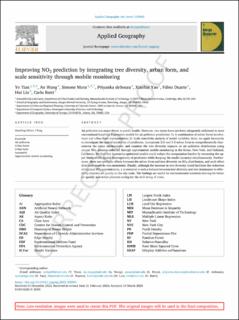| dc.contributor.author | Tian, Ye | |
| dc.contributor.author | Wang, An | |
| dc.contributor.author | Mora, Simone | |
| dc.contributor.author | deSouza, Priyanka | |
| dc.contributor.author | Yao, Xiaobai | |
| dc.contributor.author | Duarte, Fábio | |
| dc.contributor.author | Lin, Hui | |
| dc.contributor.author | Ratti, Carlo | |
| dc.date.accessioned | 2024-02-05T09:02:13Z | |
| dc.date.available | 2024-02-05T09:02:13Z | |
| dc.date.created | 2023-04-12T10:08:42Z | |
| dc.date.issued | 2023 | |
| dc.identifier.citation | Applied Geography. 2023, 154 . | en_US |
| dc.identifier.issn | 0143-6228 | |
| dc.identifier.uri | https://hdl.handle.net/11250/3115463 | |
| dc.description.abstract | Air pollution is a major threat to public health. However, two issues have not been adequately addressed in most conventional Land Use Regression models for air pollution prediction: 1). A combination of urban forest involvement and urban form representation; 2). Scale sensitivity analysis of model variables. Here, we apply lacunarity to investigate the spatial sensitivity of predictors, incorporate 2-D and 3-D urban form to comprehensively characterize the urban environment, and examine the tree diversity impacts on air pollution distribution using unique NO2 datasets collected through opportunistic mobile monitoring in the Bronx, New York, and Oakland, California. We find that lacunarity-optimized models could reduce the computation burden by extracting the upper limits of the spatial heterogeneity of predictors while keeping the model accuracy simultaneously. Furthermore, there are synthetic effects between the urban form and tree diversity on NO2 distribution, and such effect directions could be non-monotonic. Finally, although the increase in tree diversity could facilitate the reduction of regional NO2 concentration, it is essential to seek a balance between tree diversity and tree dominance to effectively improve air quality on the city scale. The findings are useful for environmental scientists striving for better air quality and urban planners caring for the well-being of cities. | en_US |
| dc.language.iso | eng | en_US |
| dc.publisher | Elsevier | en_US |
| dc.rights | Attribution-NonCommercial-NoDerivatives 4.0 Internasjonal | * |
| dc.rights.uri | http://creativecommons.org/licenses/by-nc-nd/4.0/deed.no | * |
| dc.title | Improving NO2 prediction by integrating tree diversity, urban form, and scale sensitivity through mobile monitoring | en_US |
| dc.title.alternative | Improving NO2 prediction by integrating tree diversity, urban form, and scale sensitivity through mobile monitoring | en_US |
| dc.type | Journal article | en_US |
| dc.type | Peer reviewed | en_US |
| dc.description.version | acceptedVersion | en_US |
| dc.source.pagenumber | 0 | en_US |
| dc.source.volume | 154 | en_US |
| dc.source.journal | Applied Geography | en_US |
| dc.identifier.doi | 10.1016/j.apgeog.2023.102943 | |
| dc.identifier.cristin | 2140173 | |
| cristin.ispublished | true | |
| cristin.fulltext | postprint | |
| cristin.qualitycode | 1 | |

